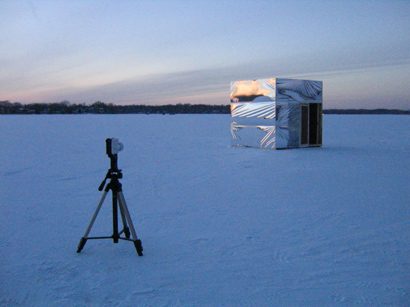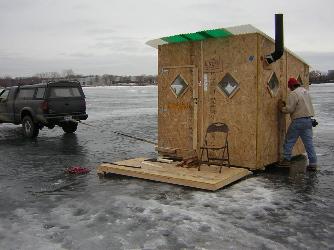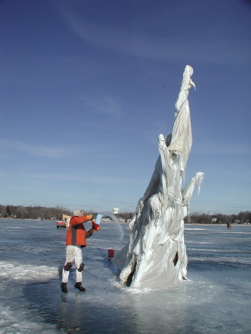Art Shanties: Frozen Pool of Inspiration
Lightsey Darst reviews the Ice Shanties on Medicine Lake--a Soap Factory project that will continue on into the summer at the Factory itself.



A few years ago I watched my future husband walk out onto a frozen lake. We were at a cabin up north, a cabin on the edge of a tremendous lake like they have up north, a lake that curls around the edge of your view and goes off in fingers and throats and mouths, a lake crossed by a road and bounded by various retreats and rustic cabins and slow-groaning dark gray reeds. The lake was frozen solid; it lay forty feet from the cabin, a white stretch that glowed in the evening, the largest chunk of ice I’d ever seen. “Is it safe?” I called to him. He had his videocamera set up on a tripod on the lake and was walking back and forth near it like a latter-day Jesus. “It’s fine, it’s two feet thick,” he said. He came to the edge where I was and pointed out a crack where we could see down into the ice. I walked about thirty feet out onto the lake with him.
Galen Treuer, a dancer with the Live Action Set, tells me I should go see the Art Shanty Project. The project’s run under the auspices of the Soap Factory; various artists are building shanties and presenting exhibitions and performances out on frozen Medicine Lake. Some of the Shanty Projects will wind up in a Soap Factory installation in July. Life in Minnesota has always felt like an act of will to me. I came up here to write and so everything that was different here (different from Florida, where I grew up) seemed to bloom out of the art itself—frosty hands on windows, snow coming down all day, even the sad pocked and pitted piles of winter in parking lot corners. Shoveling and scraping and sweeping my car out from under snow is an artistic struggle for me simply because I wouldn’t be doing it if I weren’t an artist. So the Art Shanties appeal to me instantly. I must go see them.
I drive out to Medicine Lake to see the Art Shanties. It’s just after the big snowfall in late January; the lake is rumpled, rutted, more like a field than a body of water. From the parking lot, I see two gatherings of shanties: one like a city, organized rows of varicolored shanties, all the same shape; nearer to me, a loose cluster of buildings, only a few of which adhere to the traditional square shanty form, grouped around an ice sculpture that juts sharply into the sky. Must be the Art Shanties. I tromp towards them. I’ve been told to drive my car onto the ice, but I’m afraid.
After fifteen minutes of trudging, I reach the first shanty. Locked. A tiny replica shanty sits on a stilt in front, like a craft mailbox. Little fish hang from the replica porch. The first shanty turns out to be farther from the others than it looked from the shore; I stumble to the next closest shanty. Also locked. I walk by an ice sculpture made from hundreds of ice globes. I’m more interested in finding a person to talk to than I am in looking at the sculpture; I’m cold and uncomfortable. Finally, I spot a man opening a shanty door and ask if I can come in.
His name is Paul Linden and he’s a carpenter. “What are you doing?” I ask. “Right now, I’m shoring up the roof,” he says. He’s at work on a long piece of wood, carving notches that match the corrugation of his green shed roof. “Then what?” I ask. “Well, I’m planning to put a woodstove in the corner.” “Then what?” I ask. “I have a big old workbench I’d like to get in here,” he says. “But what will you do when it’s all set up?” I ask. “Oh,” he says, getting a far-off look in his eyes, “I thought I would make a few paddles. For summer on the lake. I thought that would be fun.” I try to find out when more people will be here. Hard to say. If I don’t ask Linden a question, he says nothing. But he’s generous to let me stay here in his warm shanty.
Out in the cold again, I find the Live Action Set’s shanty, a squat structure with silver walls. I’m scared to get near it because the ice has an appalling black look around the shanty, as if someone has been melting it intentionally. But I slide up and open the door. Inside, thrown-off practice clothes cover the walls, stretchy, custom-cut schmates in drab overwashed colors. A notebook lies in a corner. I have no desire to write on it. The shanty is not warm. I leave.
I head for another shanty and stumble across a man lying full length on the lake. He’s bundled in winter gear and could be any age or even any sex. One hand is raised—in greeting or attack? But I’m not afraid, because he’s a drawing, frozen into a clear sheet of ice. The drawing style is between cartoon and police bulletin and I don’t know what to make of him. Am I being warned? Yet he’s human, and this somehow is what remains with me as I trudge back towards my car. Contact with other people is often uninformative; all you know is that someone else is alive and working.
I run into some members of the Live Action Set at a party. “You have to email me!” I squeal at Galen Treuer. “I went to the Art Shanties and no one was there!” Treuer bobs around while I’m talking to him. He’s attached to two other people, his girlfriend and Noah Bremer, another member of the Live Action Set, and I imagine them as a shaken string of fish. “When will you be out there?” I ask. Treuer and Bremer can’t tell me. They’re not sure they will be out there. They speak in overlapping sentences and move constantly. Between them and the vodka, I’m feeling dizzy. “Building the shanty kind of was the performance,” the Live Actioneers sing-song. The shanty exists as a relic of their energy, as if they’d been dancing in sand and left their footprints for us to see. “Did you go inside and shut the door?” No, I admit. “That’s the whole point,” they say. “You have to do that.” And then they’re dancing.
I take my time getting back to the Shanties. I’m busy. Anyway, I don’t like ice; I scream when I slip outside my house. Winter makes me angry and blue and I’ve come to resent all the people who tell me I just need to get out in it. On the other hand, this Minnesotan winter means all kinds of important things to me, as the ocean might if you had never seen it before and suddenly lived next to it, and I want to know how other people face and work with this force.
So on the last day of the Art Shanties (February 19), I make an appointment for a four o’clock tea with Colin Rusch (tea being some kind of dance performance) and drive out to Medicine Lake again.
The lake has changed completely; thaws rendered it slick as a mirror, and I fall down, landing in a push-up position on the ice. To avoid falling again, I penguin-walk as fast as I can—but then I’m down again, and after a second fall in a row I see a cork-covered truck heading my way. Cork Lady to the rescue. She ferries me out to a transparent shanty where I am to wait as the tea service is prepared.
In the shanty a cellist tunes up. “What are you doing?” I ask her, trying to be a good reporter. She plans to play a little bit in the shanty in a minute or two, as soon as her violinist joins her; she’s also recording noises inside and outside the shanty for a future sound installation. I watch her take off her gloves and settle down to business. She’s wearing snow pants and heavy boots and happily discusses the measures she’s taken to prevent her cello from cracking in the cold. On the shelves of this shanty I spot relics of survival: flashlight, oatmeal, taped instructions, coffee. The Art Shanties are billed as relief from the winter. No such thing; they’re a Minnesotan bear-embrace of the winter, of the winter weather, of the inhuman conditions, of the supernatural strangeness of the frozen lake. I sense glee in the Carhaart-jacketed men tromping around outside; two cars slide in synchrony beyond the shanties.
While I’m waiting for the tea, a couple shows up to share the transparent shanty with the cellist and me. The tea requires formal dress, so the couple helps me knot a tie I’ve borrowed. “Very smart!” the woman says. Next the violinist comes in; the couple leaves and another arrives. A man trains a small camera on the cellist, then sets up a laptop to display images from the shanty projects. The cellist tries to help the violinist tune up with the aid of an electronic gizmo; “See, that means your A is a little flat,” she explains. “But that was my G,” the violinist answers. Tea is not ready. The other people smile and stamp their feet; the cellist’s cell phone goes off. “It’s not the best time,” she says. “I’m in the middle of an installation performance thing.”
Feeling in the way, I leave the warm shanty and look around outside. The ice knife has changed shape since I saw it last; must have melted and fallen down. The tower of ice globes is gone as well. I pass by another mini-shanty on stilts, a “spirit shanty,” designed to appease spirits of the lake. A man is drilling a hole in the lake, and people are perversely delighted with the concept of catching an actual fish at the Art Shanties, as if any fish so caught would be an Art Fish. I’m getting cold, and frustrated; I want to enjoy myself but I’m surrounded by a culture I don’t understand, and I can’t tell whether that culture is peculiar to Minnesota, to art, or to the Art Shanties.
I walk, stumble, and slide toward the camera obscura shanty. If I understood the website right, this is where it all began, with someone realizing that a shanty could provide a vantage point on winter instead of merely locking winter out. A sign stuck to the shanty door reads, “The Poet is In.” Inside, a young couple sits on a bench. They’re eating peanuts by candlelight; they explain to me that they lit the candle because the overcast day prevents the camera obscura from functioning. The poet apparently is not in. I pick up a bronze fish with an appealingly fat body. Water runs out of the fish when I tilt it. “They just took that out of the lake,” explains the woman. “They had some fish in the water and you could look into a periscope and see them.” The couple leaves the shanty. I’m irritated with myself: I’ve missed the fish in its element; if only I’d been more of a trooper last time I could have seen the fish swimming. However, I like holding the heavy little thing. Art fish?
I return to the Live Action shanty. By this time my Reynaud’s syndrome has given me three white, dead-looking fingers. I go inside and shut the door and understand: the ice here isn’t aerated and cloudy, but clear, so that I can see down into the frozen lake. Light from outside makes the ice glow. I’m looking into green veins, lines of precious ore or star-laden universal arms or neural pathways; thought or movement or love leaps along the living networks. I’m too cold to stay, but I know I’m lucky to see this, to have a glimpse of that larger field to which both death and life belong.
Back to the wood-working shanty, which I’ve heard is the warmest. I go inside and Paul Linden has, as he said he would, set up a wood-burning stove. I warm myself and admire the collection of objects in the shanty, although I don’t see any paddles. Perhaps, for Linden, the shanty was more about the effort of surviving. Then I realize that I’m standing on a frozen lake next to a wood-burning stove, and feel that I must leave immediately, before I sink through the ice whose deathly structure I was just admiring.
The ice ladders, the spirit shanties, the ice knife, the tower of ice globes, the floor plan for a shanty, the steamship stack; all this leaves me (mind the pun) fairly cold. “You had to be there” isn’t sufficient; you had to be there and be part of it to be affected. “Project” is accurate; I see process all around me. What you are to do with these proto-installations, these notions toward art works, is another question. Admire the imagination of the artists, learn to appreciate an incomplete form? Join in this fringe of the great Minnesotan winter festival and appreciate ice and its many uses from an artist’s, rather than a sportsman’s, view? Perhaps the Shanties require that each visitor curate his or her own experience, thus displacing some of the artistic burden from the artist to the audience. I can’t help feeling that the people here are competing in their ability to enjoy the bits and pieces around us. On the other hand, I find the shanty projects sending my own imagination off in swirls and spirals; perhaps the art shanties are an act of generosity, a common, if frozen, pool of inspiration we can all draw from. In July we can see what these artists made from their sojourn on the frozen lake; in the meantime, we are free to make whatever we want from their raw material.
At last the tea service is ready. The Cork Lady will be my companion; we’re given a radio tuned to the shanties’ own frequency, on which we hear Bach organ music. Colin appears far out on the lake, wearing a long coat, running toward us. When he gets closer, we walk out to meet him at the table. He hands us teacups, spoons and saucers, pours tea, and doles out little treats with tongs. “I hope I can eat them,” says the Cork Lady. “I’m allergic to wheat. What’s that one?” As she asks, the little treat lands face down in the snow. “Garbage,” Colin answers. I’m entranced by the vision of a little chocolate mousse upside-down in the snow and long to see a huge white cake in the same predicament. Having served the tea, Colin jogs away from us again. “Milk?” offers the Cork Lady. We stir our tea. Far out on the ice, Colin stops, sets down his briefcase, and dances. At this distance, I can’t make out much about his movements. Since the soundtrack comes from our handheld radio, I feel that I’m imposing performance on a stranger, a man who might be celebrating a successful proposal, lamenting a stock market crash, or hailing a cab. The Cork Lady and I clink teacups. We have such a view: white lake, trees, panoramic sky. We know our privilege won’t last, for if we are here in a dead time, we are also here in a suspended time, when no debts are collected. Colin stops dancing and runs away from us again, then dances. His dress clothes, his swinging coat, remind me of Fred Astaire. We pour another cup of tea. We’re getting cold. Milk blooms in the tea, while far away the dancer picks up his briefcase and moves on.
_______________________________________
For more information, see www.artshantyprojects.org. The drawings are by Mike Hoyt; the cellist is Catherine Campion; the violinist is Tema Stauffer. Stephen Rife is responsible for the Ice Knife, Chris Pennington the ice globe sculpture, Samuel Brown and Karen Griffiths the spirit shanties, Xavier Tavera the ice ladders, Andrew MacGuffie the steamship, and Kari Reardon the bronze fish.